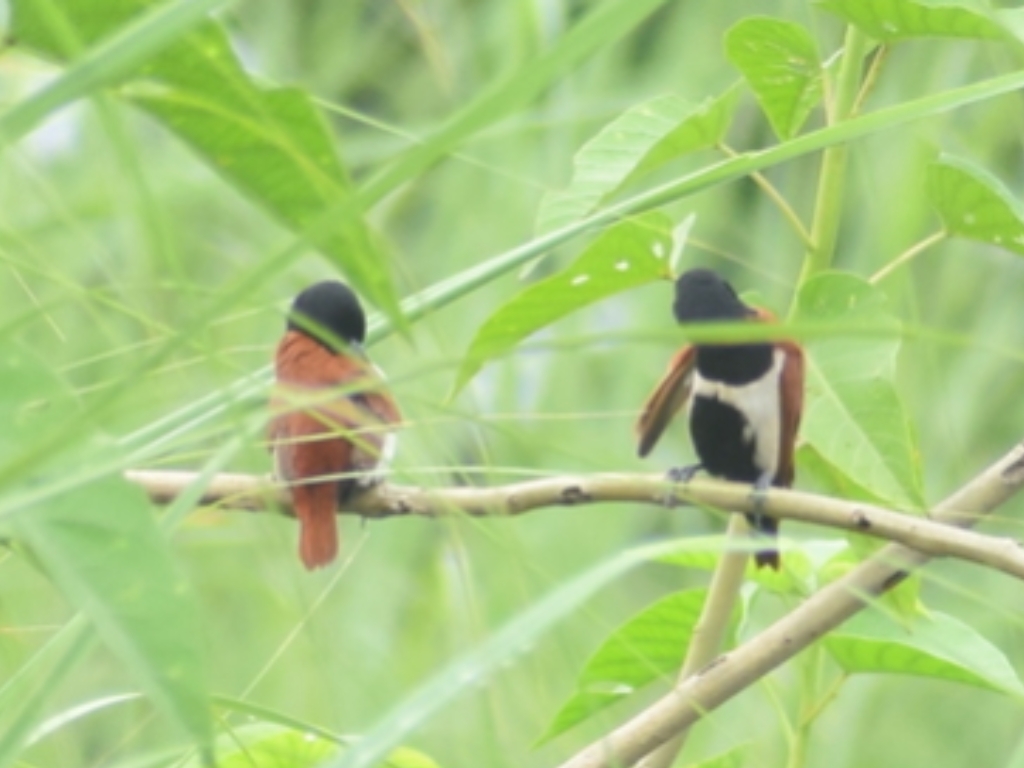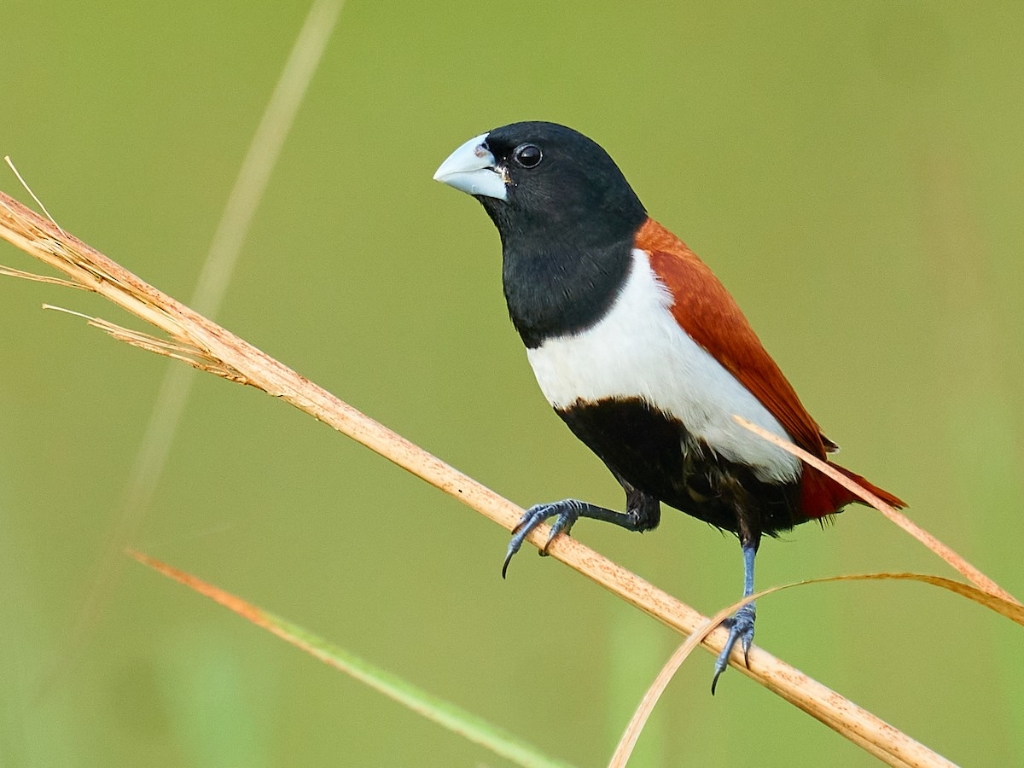Chestnut Munia (Maya)
Scientific Name: Lonchura malacca | IUCN Status: Least Concern (LC)
Taxonomy
- Scientific Name: Lonchura malacca
- Common Name: Chestnut Munia
- Local Name: Maya
- Kingdom: Animalia
- Phylum: Chordata
- Class: Aves
- Order: Passeriformes
- Family: Estrildidae
- Genus: Lonchura
- Species: malacca
- Conservation Status: Least Concern (LC)
Description
The Chestnut Munia, commonly known as Maya in the Philippines, is a small, brownish songbird with a distinctive appearance. The adult male typically has a rich chestnut-brown plumage on its body, with a black head and a contrasting white rump. Females have a more subdued coloration with browner tones, but they lack the distinct black head seen in males. Both sexes share a short, conical bill that is ideal for feeding on seeds. These birds are small, measuring about 10–12 cm in length. The Chestnut Munia is known for its social behavior and is often found in flocks.
Habitat and Distribution in Lake Mainit
- Location:
The Chestnut Munia is found in various parts of Lake Mainit, particularly in grasslands, agricultural areas, and wetlands around the lake. It is a bird adapted to living in the lowland areas of Mindanao, including near Lake Mainit’s marshy and open fields. - Habitat Type:
This species is commonly seen in open grasslands, agricultural fields, and near marshes where grasses and seeds are abundant. It prefers areas with sparse trees or scattered vegetation, often seen in rice fields, meadows, and the borders of freshwater bodies. - Water Quality:
The Chestnut Munia prefers areas with abundant seed sources in lowland areas. While it does not depend directly on freshwater for feeding, it may frequent wetlands or water-adjacent environments during the breeding season. - Native Range:
This bird species is native to Southeast Asia and has a significant presence in the Philippines, including around the Lake Mainit area. It can be found in a variety of habitats from grasslands to open woodlands, primarily in lowland areas.
- Feeding Habits:
The Chestnut Munia primarily feeds on grass seeds, grains, and small plant matter. It can often be seen foraging in groups in open fields, picking seeds from grasses and weeds. The species may also occasionally feed on small insects. - Breeding and Reproduction:
The Chestnut Munia typically breeds during the wet season. The nest is usually built in tall grass or dense vegetation, and the female lays a clutch of 4 to 6 eggs. Both parents participate in incubation and feeding the chicks. The species is monogamous during the breeding season, with pairs forming and staying together for the duration of reproduction. - Social Structure:
These birds are highly social and are often seen in small to large flocks outside of the breeding season. They are known for their cooperative behavior and can be found in groups feeding together or nesting in proximity. The species exhibits a strong flocking instinct, which offers protection from predators.
Behavior and Ecology
- Economic/Cultural Significance:
Although the Chestnut Munia itself does not have a direct economic role, it is part of the biodiversity that sustains the ecosystem around Lake Mainit. As a seed-eating bird, it plays an indirect role in local agriculture by helping control the growth of certain grasses and weeds. - Cultural Significance:
The Maya is a well-known bird species in the Philippines, often associated with Filipino culture. It is frequently kept as a pet, with its melodious song and attractive plumage. In rural areas, it may be considered a symbol of good luck and is culturally significant in various traditions. - Ecological Role:
The Chestnut Munia is an important part of the local ecosystem. By feeding on seeds and other plant material, it helps maintain a balance in the growth of certain plant species in the area. The species also serves as prey for larger predators in the food chain.
Economic and Cultural Significance
- Nutrient Cycling:
As a seed eater, the Chestnut Munia plays a role in the dispersal of seeds. While feeding on grasses and weeds, the birds help spread plant seeds over a broader area, contributing to plant regeneration and nutrient cycling in their environment. - Impact on Native Species:
The Chestnut Munia has a minimal impact on other species due to its diet of seeds and small plants. Its role in seed dispersal may even benefit certain native plant species around Lake Mainit, supporting biodiversity. - Role in Food Web:
The Maya serves as prey for a variety of predators, including larger birds of prey, reptiles, and mammals. Its role in the food web helps sustain higher trophic levels and maintains the overall ecological balance in the area.
Environmental and Ecological Impact
- Monitoring Populations:
The Chestnut Munia is not currently considered to be under significant threat. However, monitoring its populations is important, especially in areas where habitat loss due to agricultural expansion could affect local numbers. Conservation efforts focused on preserving grassland and wetland habitats would benefit the species. - Habitat Protection:
Protecting the open grasslands, wetlands, and agricultural fields around Lake Mainit is vital for the continued existence of the Chestnut Munia. Preservation of natural habitats that provide food and nesting sites will ensure a stable population. - Sustainable Practices:
While the Chestnut Munia does not directly impact agriculture, promoting sustainable land-use practices can help preserve its habitat. Practices such as reducing the use of pesticides and preventing habitat degradation can support this species and other wildlife in the area.
Conservation and Management
Reference
• BirdLife International (2021). "Lonchura malacca." The IUCN Red List of Threatened Species.
• Ramos, E. M. (2019). "Biodiversity and Conservation of Birds in Mindanao: Focusing on Lake Mainit." Philippine Journal of Ornithology.
• International Union for Conservation of Nature (IUCN), (2021). "The conservation status of Philippine bird species." Global Environmental Review.
• Photo Credits to iNaturalist



